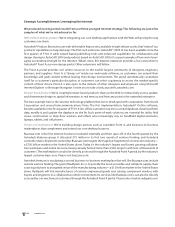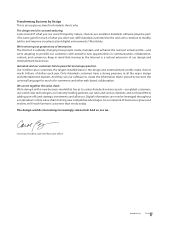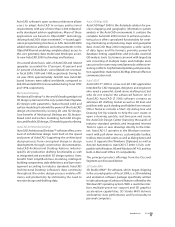Autodesk 2000 Annual Report Download - page 12
Download and view the complete annual report
Please find page 12 of the 2000 Autodesk annual report below. You can navigate through the pages in the report by either clicking on the pages listed below, or by using the keyword search tool below to find specific information within the annual report.
11
Autodesk, Inc. FY 00
From time to time Autodesk or others may announce
products, features or technologies which have the
potential to shorten the life cycle of or replace its then
existing products. Such announcements could cause
customers to defer the decision to buy or determine
not to buy its products or cause its resellers or distrib-
utors to seek to return products, any of which could
harm Autodesk’s business and consolidated results of
operations. In addition, product announcements by
SGI and others in the past have caused customers to
defer their decision to buy or determine not to buy
Autodesk’s products.Moreover, products or technolo-
gies developed by others may render Autodesk’s
products or technology noncompetitive or obsolete.
Some of Autodesk’s product development activities
are performed by independent firms and contractors,
while other technologies are licensed from third par-
ties. Autodesk generally either owns or licenses the
software developed by third parties.Because talented
development personnel are in high demand, inde-
pendent developers, including those who currently
develop products for Autodesk, may not be able to
provide development support in the future. Similarly,
Autodesk may not be able to obtain and renew exist-
ing license agreements on favorable terms, or at all,
which could harm Autodesk’s business.
Autodesk’s business strategy has historically depended
in large part on its relationships with third-party devel-
opers,who provide products that expand the function-
ality of Autodesk’s design software. Some developers
may elect to support other products or otherwise
experience disruption in product development and
delivery cycles. This disruption in particular markets
could negatively impact these third-party developers
and end users,which could harm Autodesk’s business.
Marketing and Sales
Autodesk’s customer-related operations are divided
into three geographic regions, the Americas, Europe
and Asia Pacific, and are supported by a global mar-
keting and sales organization,WWFO (worldwide field
operations).This organization develops and manages
overall marketing and sales programs and works
closely with a network of domestic and foreign offices.
Autodesk sells its software products primarily through
distributors and value-added resellers, or VARs, who
distribute Autodesk’s products to end users in more
than 150 countries.VARs, including both independent
owners and computer store franchisees,are supported
by Autodesk and its subsidiaries through technical
training and periodic publications.
In addition, Autodesk works directly with reseller and
distributor sales organizations, computer manufac-
turers, other software developers and peripheral
manufacturers through cooperative advertising, pro-
motions and trade-show presentations. Autodesk
employs mass-marketing techniques such as web-
casts, seminars, telemarketing, direct mailings and
advertising in business and trade journals. Autodesk
has a worldwide user group organization dedicated
to the exchange of information related to the use of
Autodesk’s products.
Domestically,Autodesk distributes its products prima-
rily through its authorized reseller network. Other
domestic sales are made principally to large corpora-
tions,governmental agencies,educational institutions
and, for some low-end design products, to end-users.
The majority of Autodesk’s international sales are
made to resellers and distributors, which are sup-
ported by Autodesk’s foreign subsidiaries and inter-
national sales organizations. Some international sales
result from direct exports from the United States.
Fluctuations in foreign exchange rates,specifically the
stronger value of the dollar, relative to certain interna-
tional currencies, could have a negative impact on
foreign revenues.These foreign currency fluctuations,
as well as any slowdowns in any of Autodesk’s geo-
graphical markets, could harm Autodesk’s business
and adversely impact future results of operations.
























